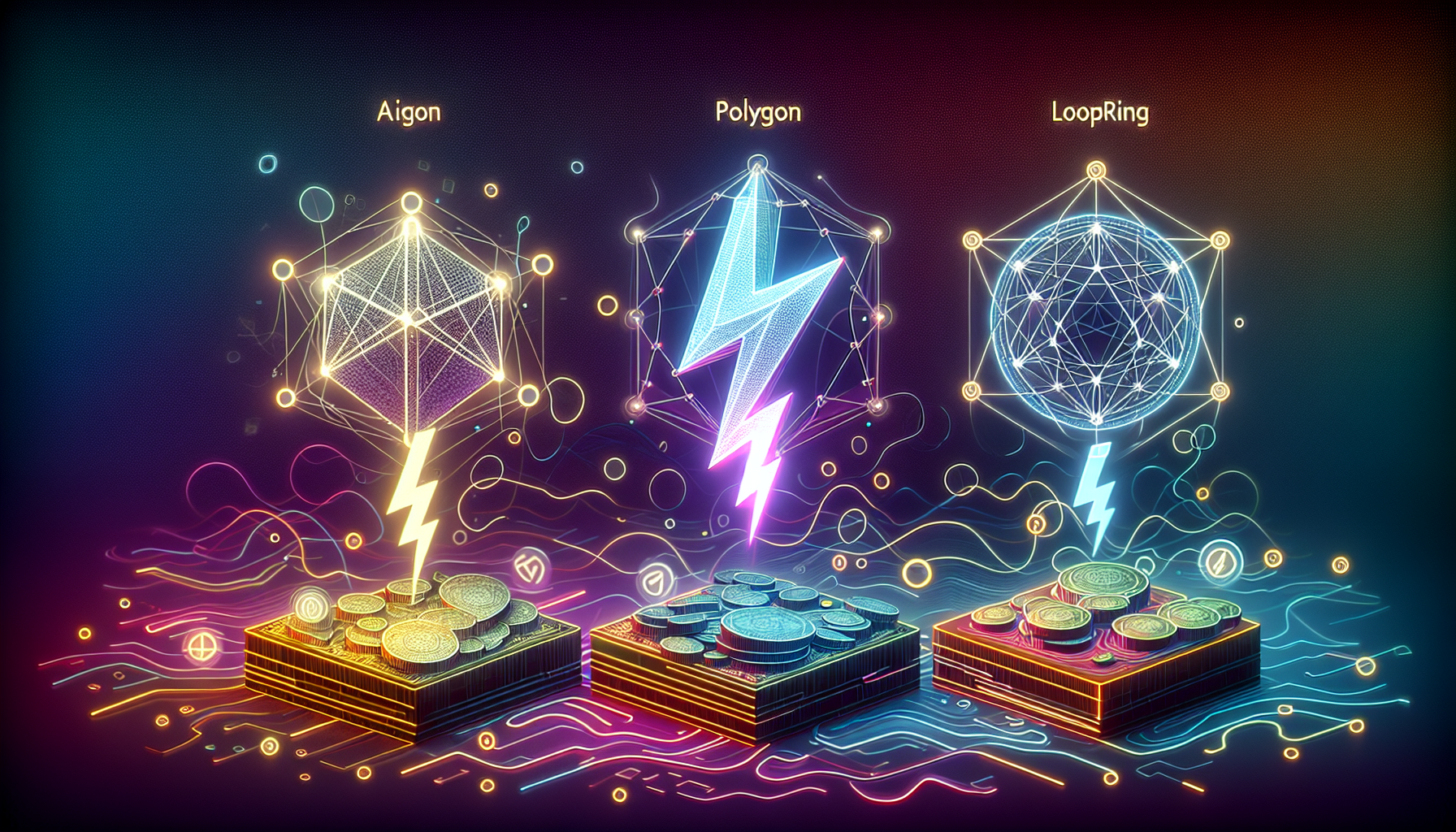Looking for a way to scale blockchain efficiently? Layer 2 solutions are the answer. These techniques process transactions off the main blockchain to cut down congestion, reduce fees, and speed up transactions. In this guide, you’ll learn how state channels, sidechains, and rollups work, and why they matter for blockchain software developers.
Key Takeaways
Layer 2 solutions, including state channels, sidechains, and rollups, are essential for addressing blockchain scalability issues by offloading computational burdens from the main blockchain while maintaining security and integrity.
State channels, sidechains, and rollups enhance blockchain performance by significantly reducing transaction fees and improving transaction speeds through various techniques such as off-chain processing and bundling transactions into single data pieces.
Real-world implementations of Layer 2 solutions, such as the Lightning Network for Bitcoin and Polygon Plasma Chains for Ethereum, demonstrate their effectiveness in increasing transaction throughput and cost-efficiency, thereby facilitating broader blockchain technology adoption across industries.
Mastering Layer 2 Solutions: A Comprehensive Guide for Blockchain Technology Developers

Blockchain technology has brought about a significant transformation in the blockchain industry and beyond by providing decentralized, transparent, and secure solutions. As its adoption continues to spread, scalability issues such as network congestion, elevated transaction fees, and sluggish confirmation times have become more pronounced. These obstacles are impeding the broader acceptance of blockchain technology.
In response to these limitations of blockchain systems, there are Layer 2 solutions that offer hope by alleviating the computational load on the main blockchain without compromising security aspects. Incorporating various mechanisms like state channels and rollups into their strategies helps enhance overall performance while keeping transactions aligned with integrity benchmarks set by underlying blockchains. For core blockchain developers and blockchain software developers who specialize in this field, mastering Layer 2 approaches is crucial for deploying scalable, effective, and economical blockchain solutions.
Layer 2 options are gaining traction indicative of their inherent capabilities which suggest Advancements and utilization shortly enhancing contemporary practices within this sphere from curbing costs associated with transactions cutting down processing lag time they’re making strides towards building out even sturdier expandable applications using-blockchain. This handbook strives to provide thorough comprehension around implementation techniques ensuring you can seamlessly integrate them your own venture related-development sector.
Introduction
Blockchain technology faces significant scalability issues that can impede its broader adoption. By processing transactions off-chain and settling them on the main chain, Layer 2 solutions are designed to alleviate these limitations, thereby easing the load on the primary blockchain. These solutions play a vital role in unleashing the full potential of blockchain technology, facilitating faster transactions, lower fees, and enhanced overall efficiency. Blockchain software developers are crucial in implementing these Layer 2 solutions, handling the development of decentralized applications (dApps) and smart contracts, and understanding the architecture and protocols of the technology.
This guide navigates aspiring blockchain developers through the world of Layer 2 solutions, equipping them with the knowledge and tools required to excel at this innovative facet of blockchain development and become a core blockchain developer.
Understanding Layer 2 Solutions

Solutions at Layer 2 are engineered to amplify the scalability and performance of blockchain networks through handling transactions away from the main chain. Utilizing mechanisms including state channels, sidechains, and computations performed off-chain, these advanced solutions tackle prevailing challenges related to high fees for transactions and overburdened networks. The ultimate aim of such Layers is lightening the load on the primary blockchain, thereby diminishing congestion while boosting overall system capability.
Through state channels, a multitude of transactions can be executed off chain between parties with only the net result being committed onto the core blockchain ledger. This mode vastly cuts down on necessary on-chain transaction processing volume, which translates into expedited operational timescales as well as diminished costs associated with each transaction.
In parallel realms are sidechains—autonomous blocks joined to that centralised series through bilateral linkages—that facilitate swift movements of digital assets among them while rollups efficiently condense numerous transactions into singular entries thus mitigating strain upon that all-important initial sequence’s capacity.
Networks based around Ethereum’s second layer like Polygon retain integrity found within Ethereum while hastening those very ethereum-based dealings they were designed to streamline more cost-effectively by excising superfluous computational demands traditionally placed upon its originating chain yet without forfeiting said original platform’s foundational security measures—proving themselves crucial players in what promises to be an evolving ecosystem ripe for expansive growth thanks mainly due once again their contributions towards rendering operations underpinned by such decentralized ledgers increasingly viable long-term propositions. Blockchain software developers play a pivotal role in this ecosystem by building decentralized applications (dApps) and smart contracts, ensuring the architecture and protocols of these Layer 2 solutions are robust and efficient.
How State Channels Work with Smart Contracts
State channels are an innovative approach to facilitating transactions off the main blockchain, thus alleviating congestion on it. By enabling a series of transactions to occur away from the main chain, these channels can significantly reduce associated transaction fees and increase speeds. State channels mainly involve updates of state, digital signature authentication, and ultimately submitting the final state.
Blockchain software developers play a crucial role in setting up and maintaining these state channels.
In practice, participants in a state channel agree upon multiple transactions through mutual consent by creating and approving them with their digital signatures. These authorized interactions effectively reserve certain portions of the blockchain’s capacity for updates that only take place when all involved parties are in agreement. When ready to close out the channel events sequence or relationship between parties within this separate space, they execute what is known as “state submission,” where they commit their last agreed-upon version back into the smart contract on the leading chain.
Thus enabled by smart contracts’ capabilities for interaction outside of direct oversight by every single participant network-wide—a functionality made possible specifically via utilization of such ‘off-chain’ occurrences—these alternative conduits manage considerably more efficient throughput than if each operation were registered individually directly onto its home platform ledger itself.
True whether we’re measuring efficiency according to accountings taken per incident volume or those compared based costs otherwise incurred during course ordinary proceedings witnessed over same spans elsewhere under normal conditions without benefiting said enhancements at play throughout course typical day’s ongoing commerce activities conducted therein collectively overall.
Exploring Sidechains

Sidechains are autonomous blockchains designed to facilitate swift transaction processing through the transfer of assets between themselves and the primary chain. These sidechains function with autonomy, implementing their own consensus mechanisms and security measures, separate from those of the main blockchain.
The dual-direction peg system ensures that these chains can interoperate by enabling asset transfers to and from the principal blockchain. Blockchain software developers play a crucial role in managing these sidechains, handling front-end and back-end development, design, and maintenance.
Polygon stands out as a key example of such a technology – an Ethereum-linked independent sidechain characterized by:
Enhanced speed and lower cost for transactions relative to Ethereum
Employs validators who compile transactions into blocks
Sends these bundles back to the Ethereum network for ultimate confirmation
Has the capacity to offload some demands from the overloaded Ethereum network, which facilitates more efficient handling of transactions.
Tailored specifically according since requirements vary—ranging from accelerated transaction speeds or strengthened privacy provisions up until distinctive smart contract functionalities—sidechains offer dedicated avenues for processing operations distinctively whilst mitigating traffic on this central-blockchain structure thus contributing towards better scalability as well enhancing total potential throughout its operation span regarding numerous concurrent proceedings.
The Concept of Rollups ->
Layer 2 solutions known as rollups aggregate numerous transactions into a condensed form before committing them to the main chain, thereby decreasing the volume of on-chain activity and enhancing transaction processing capacity.
Blockchain software developers play a crucial role in implementing these rollups by developing decentralized applications (dApps) and smart contracts based on blockchain technology.
These rollups come in two primary forms: Optimistic Rollups and Zero Knowledge Rollups (zk rollups), each significantly boosting scalability and cost effectiveness by merging transactions off the main blockchain.
Optimistic Rollups
Optimistic Rollups operate on the premise that all transactions within Layer 2 are considered legitimate unless a validator on the network identifies and challenges an illegitimate transaction. During a predetermined challenge period, any participant has the right to contest transactions that they believe are invalid, thereby maintaining data integrity.
When validating transactions, if one is disputed, there is a ‘fraud-proof’ process in place to identify and discard those that do not meet validation criteria.
The use of Optimistic Rollups brings several advantages for transactions.
They enjoy presumed validity with verification occurring only when contested. This greatly alleviates computational demands placed upon the main blockchain.
Enhanced scalability and reduced costs arise from diminishing the necessity for direct on-chain transaction verification processes.
The system upholds rigorous standards for both data accuracy and protection against security breaches.
ZK Rollups
Zero-Knowledge Rollups, also known as zk Rollups, utilize the concept of zero knowledge proofs to authenticate transactions prior to their incorporation into the blockchain. This verification process operates on the principle that each transaction is presumed invalid until it can be confirmed as true by Zero Knowledge Proofs (ZKPs), thus guaranteeing a robust layer of security and confidentiality.
To confirm that all multiple transactions recorded on Ethereum’s blockchain are genuine, zk Rollups deploy ‘validity proofs’ to validate and include transaction data. By bundling thousands of separate transactions into just one proof, these validity proofs expedite and fortify the authentication process compared with other methods.
The resultant condensed data set minimizes what must be processed directly on-chain. This consolidation serves to obscure individual transaction details from public view by compiling numerous transactions together in an aggregated form—an additional boon for privacy preservation.
Plasma Chains Explained

Layer 2 solutions, like plasma chains, enhance the capability to process a substantial number of transactions by branching off from the main blockchain into smaller, separate blockchains referred to as ‘Plasma chains’ or ‘child chains.’’ These auxiliary channels autonomously handle transaction processing and intermittently consolidate their results onto the principal chain.
By instituting a hierarchical network of blockchains reminiscent of tree branches, Plasma permits these subordinate chains to manage their own transactions while sending condensed information back up to the root. An infinite expansion of child chains can be achieved through this structure. Each functions independently in terms of transaction handling.
To maintain robust security links between these subsidiary ledgers and ensure integrity throughout communication lines with parent ledgers, fraud proofs are utilized. Thereby safeguarding dispute resolution mechanisms which reinforce both security standards and system efficacy overall. Blockchain software developers play a crucial role in setting up and maintaining these plasma chains, ensuring their proper design, development, and maintenance.
Increasing Transactions Per Second (TPS) for Ethereum Transactions
Blockchain networks can handle a markedly higher transaction rate per second (TPS) with the adoption of layer 2 solutions, which improve network performance by offloading transactions from the primary blockchain.
Solutions like rollups increase throughput by processing transactions outside of the main chain and then consolidating them into single batch submissions to the foundational Layer 1 blockchain, thus alleviating congestion. Blockchain software developers play a crucial role in optimizing TPS using Layer 2 solutions by developing decentralized applications (dApps) and smart contracts based on blockchain technology.
The Lightning Network and plasma chains exemplify additional layer 2 mechanisms that enhance scalability through external transaction processing before recording consolidated outcomes on the central ledger. The Lightning Network is capable of supporting millions of TPS in contrast to Bitcoin’s standard capacity of merely 7 TPS. In parallel, Polygon boasts an impressive capability for handling approximately 7,200 TPS at a nominal average gas cost of just $0.01 per transaction.
Lowering Transaction Fees With Off-Chain Processing
Processing transactions off the main blockchain network, also known as executing them “off chain,” provides multiple advantages. These include:
Diminishing the congestion on the central blockchain network
Decreasing costs associated with transaction fees
Consolidating numerous transactions and recording only their cumulative outcome onto the main ledger
Reducing fee-incurring transaction counts
Boosting overall efficiency and economic feasibility for frequent, smaller payments.
Blockchain software developers play a crucial role in implementing off-chain processing solutions, ensuring the seamless integration and maintenance of these systems.
By channeling transactions away from the primary ledger, layer 2 solutions such as Plasma Chains by Polygon can vastly improve a blockchain’s performance while mitigating bottlenecks and lowering fees. Through consolidating groups of transactions into single batch submissions – a method employed by rollups – they are able to substantially reduce transaction expenses.
Enhancing Speed and Responsiveness
Layer 2 solutions address blockchain congestion by allowing transactions to occur off the main chain, significantly improving processing speed.
Transactions on Polygon’s Plasma Chains are nearly instantaneous, providing a better user experience for decentralized applications. Off-chain computation allows for computationally intensive tasks to be performed off-chain, reducing the load on the main chain and enhancing the overall speed and responsiveness of blockchain applications. Blockchain software developers play a crucial role in improving the speed and responsiveness of blockchain applications using Layer 2 solutions.
By improving transaction speed and responsiveness, Layer 2 solutions provide a competitive edge to blockchain applications, enabling them to offer a user experience comparable to traditional digital platforms. This results in significant advancements in blockchain technology, including:
Faster transaction processing
Lower fees
Scalability
Improved user experience
These advancements make blockchain more accessible and practical for everyday use.
Addressing Security Concerns
By handling transactions off the main blockchain, Layer 2 solutions enhance transaction speeds and only settle on-chain when it’s absolutely necessary. This approach narrows the time frame for possible attacks to occur.
By alleviating the overload on the primary blockchain network, these solutions help mitigate risks related to cyber-attacks that could arise during periods of high traffic.
To ensure both integrity and safety of transactions, Layer 2 protocols implement security measures such as encryption methods, fraud-proof systems and conflict resolution processes. Layer 2 options offer various degrees of security models tailored to user preferences.
Enabling individuals to make informed decisions about whether they value speed over enhanced security features—or vice versa—thereby achieving an equilibrium between rapidity, efficacy and robust defense mechanisms against threats. Blockchain software developers play a crucial role in ensuring the security of Layer 2 solutions by developing decentralized applications (dApps) and smart contracts, and understanding the architecture and protocols of the technology.
Ensuring Compatibility With Different Blockchain Networks
Achieving compatibility with diverse blockchain networks poses a substantial challenge for Layer 2 solutions. Interoperability is crucial as it allows for smooth transitions and integrations between various blockchain protocols, maintaining security and efficiency. Considerations such as:
Scalability
Security
Cost-effectiveness
Interoperability
are crucial when selecting a Layer 2 solution. Blockchain software developers play a key role in achieving compatibility with different blockchain networks by developing decentralized applications (dApps) and smart contracts, and understanding the architecture and protocols of the technology.
Technical challenges such as data availability for off-chain transactions add complexity to ensuring compatibility with multiple blockchain networks.
However, by verifying that Layer 2 solutions can effectively integrate with different Layer 1 blockchains, developers can ensure broader adoption and more robust applications.
Real-World Examples of Layer 2 Solutions ->

Practical applications of Layer 2 solutions showcase their efficacy in improving blockchain networks by scaling up, accelerating transactions, and reducing costs. The Lightning Network is a significant instance for Bitcoin, while Ethereum benefits from the use of Optimistic Rollups. These real-world examples embody the application of theoretical ideas to advance blockchain technology. Blockchain software developers play a crucial role in implementing these real-world solutions by building decentralized applications (dApps) and smart contracts, and understanding the architecture and protocols of the technology.
Lightning Network
The Lightning Network serves as a Layer-2 protocol that augments Bitcoin by facilitating expedited and more economical transactions through off-chain payment channels. Highlighted characteristics of the Lightning Network include:
Execution of transactions via off-chain payment channels
Swift and streamlined transfers
Decreased costs associated with conducting transactions
The option for maintaining open-ended payment conduits or terminating them after specific exchanges
Engagement with the Lightning Network ensures users benefit from accelerated and less expensive engagements within Bitcoin operations.
By catering to swift micropayments at minimal costs, the capabilities for processing Bitcoin’s financial interactions receive considerable enhancement thanks to the Lightning Network. Cryptocurrency platforms such as Kraken along with Block’s Cash App have adopted this network aiming for augmented efficiency in their transaction services.
Notably, this secondary layer technology escalates not just the speeds related to executing trades, but also reduces security risks tied to frequent dealings recorded directly onto blockchain ledgers due to fewer required on-chain activities.
Polygon
Polygon employs Plasma chains as a secondary layer (Layer-2) on top of the Ethereum blockchain to tackle scalability issues. This strategy offloads some of the transactional burden from the mainnet, enabling faster and more economical transaction processing.
The sidechain solution proposed by Polygon has multiple advantages.
It maintains periodic alignment with the primary Ethereum chain to guarantee consistency and cross-chain functionality.
Its independent functioning reduces traffic on the core blockchain network, thereby boosting overall capacity for scaling.
The use of such a sidechain improves interactions with decentralized applications, offering an enhanced user experience.
Loopring
Powered by the Ethereum virtual machine, Loopring employs zk-rollups to enhance the Ethereum network with several advantages.
Transaction costs are reduced
Scalability is vastly improved
Bundled transactions are authenticated through cryptographic proofs
Each transaction’s validity is confirmed while keeping its specifics private
Privacy and scalability get a simultaneous boost
Loopring’s integration of non-custodial exchange and payment protocols ensures that users can access robust security inherent to Ethereum. This harmonizes enhanced autonomy with fortified transaction security. By aggregating multiple transactions into one cohesive proof, Loopring’s zk-rollups notably diminish the on-chain processing demand, thereby accelerating transaction speed and improving cost efficiency.
Transforming Industries With Layer 2 Solutions
Blockchain applications are experiencing a revolution due to the introduction of layer 2 solutions, which enhance scalability and efficiency across various industries. In the financial sector, platforms such as Avalanche offer expedited and discrete transaction processes that align perfectly with the demands of finance-focused blockchain use cases.
These advanced solutions also bring down costs associated with transactions, encouraging integration into mainstream use. Blockchain software developers play a crucial role in transforming industries by building decentralized applications (dApps) and smart contracts using Layer 2 solutions.
When it comes to managing supply chains, sidechains present a highly scalable alternative capable of implementing blockchain solutions for instantaneous tracking and automated data management. Similarly, in realms like gaming and NFT markets where high-transaction volumes prevail, these secondary protocols alleviate stress on the main chain by handling intensive loads for unique tokens seamlessly. Layer 2 technologies thus provide groundbreaking answers to challenges within different sectors, laying groundwork for widespread implementation of blockchain technology.
Staying Informed and Integrating Layer 2 Solutions
Staying current with the evolution of Layer 2 technology is critical for blockchain developers, as these solutions are key to handling the rising use of blockchain while keeping transactions affordable. The technical complexity involved in deploying these layer 2 enhancements demands considerable effort and a high level of expertise from developers.
The ability for Layer 2 solutions to interoperate allows for seamless interactions and connections among various blockchain protocols, boosting efficiency across the board. Blockchain software developers play a crucial role in staying informed and integrating these Layer 2 solutions, ensuring the development of decentralized applications (dApps) and smart contracts based on blockchain technology.
Entering into collaborations with Web3 agencies offers projects an opportunity to capitalize on cutting-edge developments in Layer 2 technologies—maintaining their edge in innovation and competitiveness. Through embedding such advancements within their respective blockchains, developers can substantially improve scalability, reduce operational costs, elevate user experiences—and thus harness maximum benefit from what blockchain technology has to offer.
Summary
The blockchain sector is undergoing a transformation with the advent of Layer 2 solutions that tackle issues like scalability, all while accelerating transactions, reducing costs, and boosting efficiency. These technologies include state channels, sidechains, rollups and Plasma chains which process transactions off-chain but still preserve the security features of the primary blockchain.
Blockchain software developers play a crucial role in this context by building decentralized applications (dApps) and smart contracts, handling both front-end and back-end development, and ensuring the design and maintenance of these solutions.
Blockchain developers who keep abreast of these developments can build applications on the blockchain that are more scalable, efficient and economical. As embrace for blockchain technology continues to expand, it’s clear that Layer 2 solutions will be pivotal in unleashing its true capabilities—facilitating wider adoption and powering stronger applications.
Frequently Asked Questions
What are Layer 2 solutions in blockchain?
Technologies constructed on top of the main blockchain, known as Layer 1, constitute layer 2 solutions in the realm of blockchain. Their purpose is to carry out transactions off-chain with an aim to alleviate network congestion and enhance scalability capabilities.
How do state channels work in Layer 2 solutions?
State channels enhance speed and reduce transaction fees by facilitating numerous transactions between users off-chain, with only the final result documented on the main blockchain.
Sidechains augment blockchain networks by handling transactions more quickly, increasing scalability, and reducing the load on the main blockchain through asset transfers between the main chain and the sidechain.
These auxiliary chains improve the functionality and effectiveness of the primary blockchain network.
How do rollups improve blockchain efficiency?
Rollups enhance blockchain efficiency by consolidating numerous transactions into a single transaction executed on the main chain. This process cuts down the number of on-chain transactions, thereby boosting throughput and leading to greater scalability as well as cost savings.
By optimizing this method, it simplifies the entire workflow and renders it more economical.
What are the security concerns associated with Layer 2 solutions?
To maintain the security of transactions on Layer 2 solutions, it is crucial to engage in constant monitoring as well as establish strong fraud proofs and conflict resolution processes that preserve the integrity of transactions.
Addressing these issues is essential for upholding secure transaction practices within Layer 2 frameworks.
Posted in Blockchain, NFT, Software Development, Technologies





